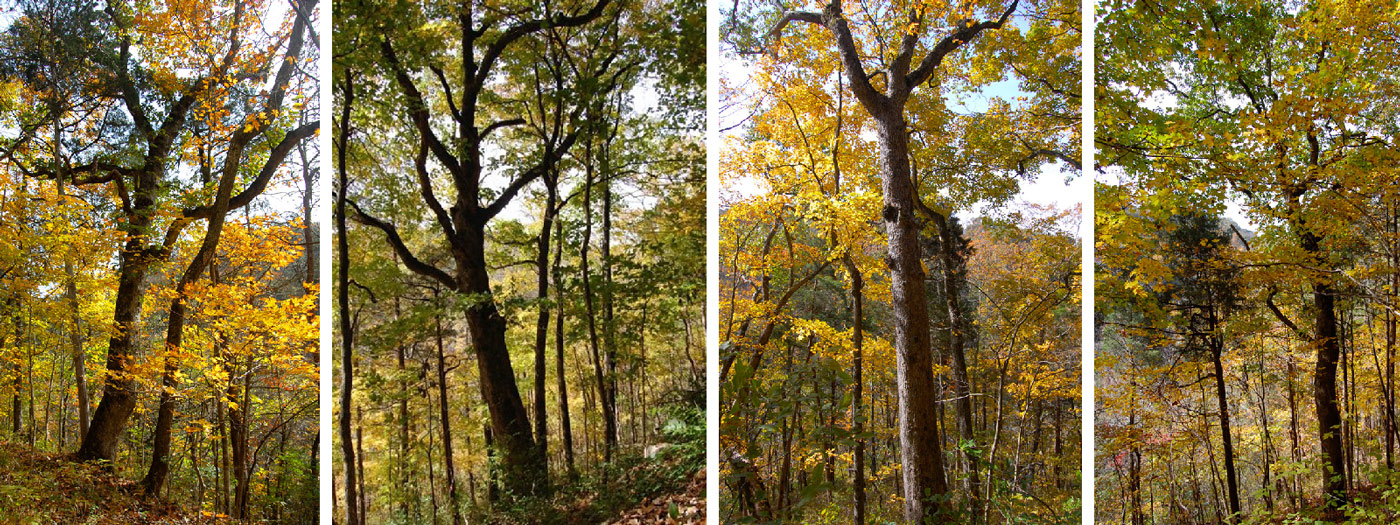
Old-growth forests are a rare element in the Inner Bluegrass Region. So, it was a great delight when old trees were discovered at Floracliff.
Old trees are windows into historical events. The science of tree-ring analysis takes advantage of a characteristic common to all trees: no matter how bad things get – an approaching fire, tornado, drought, etc. – trees must stay in place and absorb these abuses. Though each tree is an individual, environmental events like these impact all trees in a similar fashion: events that limit a tree’s ability to gain energy reduce the annual ring width. Scientists interpret patterns of ring widths within tree populations to reconstruct environmental history. To date, tree-ring scientists have successfully reconstructed drought history, Northern Hemisphere temperature, fire histories, insect outbreaks, etc. Tree-ring studies have also enriched human history. For example, scientists have dated logs from ancient structures that, in turn, triggered revisions of human history. Similarly, tree-ring evidence indicates that a severe drought likely contributed to the failure of The Lost Colony in Roanoke, NC and to the outbreak of a highly-contagious disease and subsequent crashes of the human population in ancient Mexico City. Just a few old trees in a small landscape can shed light into long-forgotten or unobserved events.
In late-summer ’08, Floracliff¹s preserve manager, Beverly James, contacted me about sampling some trees in Floracliff to gain insight into the preserve’s ecological history. Having been in Floracliff previously, I was skeptical that the coring of any trees would reveal much beyond the fact that Floracliff was a young forest heavily cut within the last 100 years. While the initial trees I was led to looked promising, based on the general disturbance history of the Inner Bluegrass Region, I thought 180-200 year old trees would be the best we could do.
In mid-fall, with permission from the Kentucky State Nature Preserves Commission, twenty chinkapin oaks with external characteristics of old age were selected and cored. Field examination of the cores from the first two trees was intriguing; I hoped that these trees were 180-200 years of age. Fantastically, my field estimates were off by a factor of two: the age of the first tree is at least 372 years while the second tree is at least 398 years!! Final ages for these oaks reveals 13 trees pre-dating Daniel Boone & James Harrod (all having an inner ring date of 1759), 10 trees dating to 1697 or earlier, six trees dating to the early-1660s or earlier, and three trees dating to the late-1630s or earlier. The oldest tree dates to 1611 and is currently the oldest-documented tree in Kentucky; it is also the second-oldest documented chinkapin oak globally. Obviously, these results are thrilling.
I taught a course at Eastern Kentucky University on the ecology of old- growth forests. A reoccurring theme throughout the course was, “What is an old-growth forest?” As our society progresses and understands the value of biological conservation, this question becomes pertinent. If the definition of an old-growth forest is simply a forest untouched by people of European descent, then there are no old-growth forests and little incentive to protect once, twice or thrice disturbed forests. However, if we define old-growth forests using the philosophy of Michael Pollan, who states that old-growth forests (or anything natural) will only persist because of human will, then it makes sense to allow the influence of humans into the old-growth forest definition. Making this allowance then allows for future creation and restoration of old-growth forests, a concept that the former definition makes impossible.
Even though this environmental investigation has closed, I look forward to the future of Floracliff and discoveries of the environmental history of the Inner Bluegrass Region. Floracliff is a rare gem of the Inner Bluegrass; it can seed restoration of future old- growth forests while providing hope for the discovery of more forests with similar connections to ancient times. Floracliff will also be the lead forest in the reconstruction of regional environmental and human history. Its trees can help us answer questions such as, “What was the climate like during the settlement of Fort Boonesborough, Harrodsburg and Danville?” and “Were there any large-scale disturbances in the forests of the Inner Bluegrass region during the last 300 years?” The rare old trees of Floracliff will reveal important slivers of historical Fayette County ecology slivers which will allow us to ponder and construct plans for a more sensible and hopeful future environment.
Dr. Neil Pederson is currently a Senior Investigator at Harvard Forest.
Watch Dr. Pederson’s presentation:
On Old Trees, Keeping an Open Mind, and Ecological Discovery

